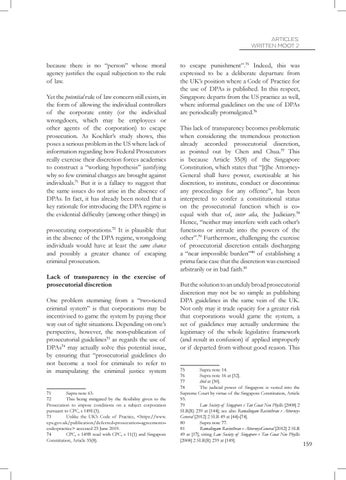ARTICLES: WRITTEN MOOT 2
because there is no “person” whose moral agency justifies the equal subjection to the rule of law. Yet the potential rule of law concern still exists, in the form of allowing the individual controllers of the corporate entity (or the individual wrongdoers, which may be employees or other agents of the corporation) to escape prosecution. As Koehler’s study shows, this poses a serious problem in the US where lack of information regarding how Federal Prosecutors really exercise their discretion forces academics to construct a “working hypothesis” justifying why so few criminal charges are brought against individuals.71 But it is a fallacy to suggest that the same issues do not arise in the absence of DPAs. In fact, it has already been noted that a key rationale for introducing the DPA regime is the evidential difficulty (among other things) in prosecuting corporations.72 It is plausible that in the absence of the DPA regime, wrongdoing individuals would have at least the same chance and possibly a greater chance of escaping criminal prosecution. Lack of transparency in the exercise of prosecutorial discretion One problem stemming from a “two-tiered criminal system” is that corporations may be incentivised to game the system by paying their way out of tight situations. Depending on one’s perspective, however, the non-publication of prosecutorial guidelines73 as regards the use of DPAs74 may actually solve this potential issue, by ensuring that “prosecutorial guidelines do not become a tool for criminals to refer to in manipulating the criminal justice system 71 Supra note 63. 72 This being mitigated by the flexibility given to the Prosecution to impose conditions on a subject corporation pursuant to CPC, s 149E(3). 73 Unlike the UK’s Code of Practice, <https://www. cps.gov.uk/publication/deferred-prosecution-agreementscode-practice> accessed 23 June 2019. 74 CPC, s 149B read with CPC, s 11(1) and Singapore Constitution, Article 35(8).
to escape punishment”.75 Indeed, this was expressed to be a deliberate departure from the UK’s position where a Code of Practice for the use of DPAs is published. In this respect, Singapore departs from the US practice as well, where informal guidelines on the use of DPAs are periodically promulgated.76 This lack of transparency becomes problematic when considering the tremendous protection already accorded prosecutorial discretion, as pointed out by Chen and Chua.77 This is because Article 35(8) of the Singapore Constitution, which states that “[t]he AttorneyGeneral shall have power, exercisable at his discretion, to institute, conduct or discontinue any proceedings for any offence”, has been interpreted to confer a constitutional status on the prosecutorial function which is coequal with that of, inter alia, the Judiciary.78 Hence, “neither may interfere with each other’s functions or intrude into the powers of the other”.79 Furthermore, challenging the exercise of prosecutorial discretion entails discharging a “near impossible burden”80 of establishing a prima facie case that the discretion was exercised arbitrarily or in bad faith.81 But the solution to an unduly broad prosecutorial discretion may not be so simple as publishing DPA guidelines in the same vein of the UK. Not only may it trade opacity for a greater risk that corporations would game the system, a set of guidelines may actually undermine the legitimacy of the whole legislative framework (and result in confusion) if applied improperly or if departed from without good reason. This 75 Supra note 14. 76 Supra note 16 at [32]. 77 ibid at [30]. 78 The judicial power of Singapore is vested into the Supreme Court by virtue of the Singapore Constitution, Article 93. 79 Law Society of Singapore v Tan Guat Neo Phyllis [2008] 2 SLR(R) 239 at [144]; see also Ramalingam Ravinthran v AttorneyGeneral [2012] 2 SLR 49 at [44]-[74]. 80 Supra note 77. 81 Ramalingam Ravinthran v Attorney-General [2012] 2 SLR 49 at [17], citing Law Society of Singapore v Tan Guat Neo Phyllis [2008] 2 SLR(R) 239 at [149].
159
